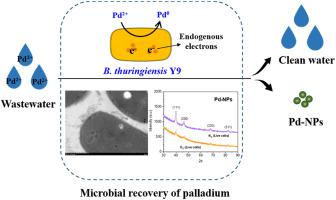Journal of Cleaner Production ( IF 9.7 ) Pub Date : 2022-06-25 , DOI: 10.1016/j.jclepro.2022.132880 Yuan Chen , Yuancai Chen , Boxi Wang , Chenchen Mao , Chao Liu , Rongrong Liu , Bing Yan

|
Microbial reduction is a sustainable approach for both environmental remediation and recycling of precious metals from waste. Bacteria-mediated reduction of palladium ions (Pd2+) in wastewater under mild conditions is such a strategy. However, external electron donors are usually required for palladium bioreduction. Herein, a novel gram-positive bacterium, Bacillus thuringiensis Y9 (B. thuringiensis Y9), was found to reduce Pd2+ to palladium nanoparticles (Pd-NPs) with endogenous electron donors. Transcriptomic analyses revealed 443 and 439 differentially expressed genes response to palladium treatment under anaerobic and aerobic conditions, respectively. It was found the genes encoding NADH-quinone oxidoreductase, dehydrogenases, cytochrome c reductase, cytochrome c oxidase, quinone cycle and ribE in B. thuringiensis Y9 have strong positive relationship to palladium reduction. The removal efficiencies of palladium by B. thuringiensis Y9 are as high as 93 mg g−1 under anaerobic conditions and 60 mg g−1 under aerobic conditions. Hydrogenase also plays vital role in the bioreduction process. The maximum Pd removal ratio of 99.18% was obtained with the primary influencing factors using response surface methodology (RSM). Our study provides a novel and sustainable strategy for Pd recovery from wastewater. The transcriptome data are valuable for understanding the global bioreduction mechanism of the microbial conversion of palladium.
中文翻译:

从垃圾到宝藏:苏云金芽孢杆菌 Y9 将钯污染物微生物转化为有价值的 Pd 纳米颗粒
微生物减少是环境修复和从废物中回收贵金属的可持续方法。在温和条件下细菌介导的废水中钯离子 (Pd 2+ ) 的还原就是这样一种策略。然而,钯的生物还原通常需要外部电子供体。在此,发现一种新型革兰氏阳性细菌苏云金芽孢杆菌Y9 ( B. thuringiensis Y9) 可将 Pd 2+还原为钯纳米颗粒(Pd-NPs) 与内源电子供体。转录组学分析显示,分别有 443 和 439 个差异表达的基因在厌氧和需氧条件下对钯处理有反应。发现编码苏云金芽孢杆菌Y9中NADH-醌氧化还原酶、脱氢酶、细胞色素c还原酶、细胞色素c氧化酶、醌循环和ribE与钯还原具有强正相关关系。B. thuringiensis对钯的去除效率在厌氧条件下高达 93 mg g-1-1在有氧条件下。氢化酶在生物还原过程中也起着至关重要的作用。使用响应面法 (RSM)获得主要影响因素的最大 Pd 去除率为 99.18% 。我们的研究为从废水中回收 Pd 提供了一种新颖且可持续的策略。转录组数据对于理解钯的微生物转化的全球生物还原机制很有价值。











































 京公网安备 11010802027423号
京公网安备 11010802027423号